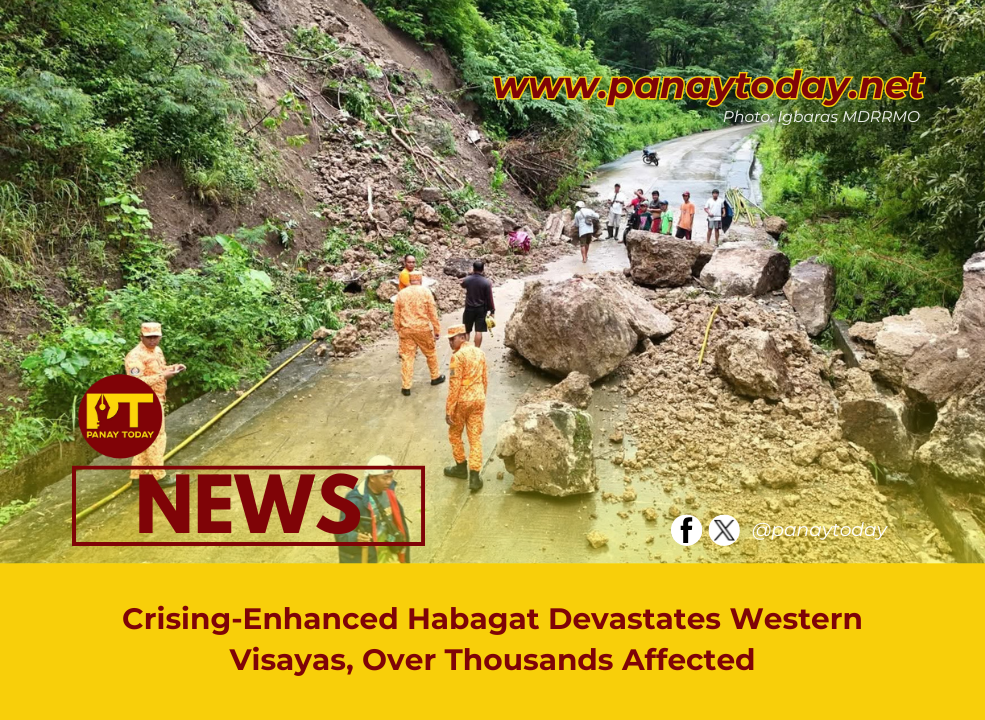Western Visayas, Philippines — While Tropical Cyclone Crising did not make landfall in the Philippines, its intensification of the Southwest Monsoon (Habagat) resulted in widespread severe weather across the western regions of the country, with Western Visayas experiencing particularly significant impacts.
According to the initial data of the Panay Center for Disaster Response (PCDR), a local non-government organization, as of noon today, July 22, an estimated 38,000 families—equivalent to approximately 135,000 individuals—have been affected across 416 barangays in 40 municipalities and cities. This information is based on consolidated data from multiple sources, including National Disaster Risk Reduction and Management Council (NDRRMC) Situation Report No. 10, Department of Social Welfare and Development (DSWD) DROMIC Report No. 10, reports from various Local Disaster Risk Reduction and Management Councils (LDRRMCs), and ground-level assessments conducted by PCDR’s Disaster Preparedness Committees and partner organizations within the Network for Disaster Response – Panay.
Severe Impact Across Iloilo, Antique, Aklan
In Aklan Province, sustained rainfall caused significant flooding and landslides, particularly in low-lying areas of Madalag and Ibajay. The Madalag Municipal Disaster Risk Reduction and Management Office (MDRRMO) reported agricultural damages estimated at ₱1.2 million. Additionally, two major infrastructure facilities were totally destroyed: the National Bridge in Tigum, Buruanga, and the Flood Control Structure in Mobo, Kalibo, with combined estimated losses exceeding ₱43.8 million.
A province-wide power outage occurred on July 19 but has since been restored. Classes at all levels have been suspended across Aklan since July 17, disrupting education province-wide. As of NDRRMC Report No. 10, 915 families in Aklan have received government assistance.
In Antique Province, continuous rainfall triggered widespread destruction to infrastructure, including houses, bridges, schools, and utility lines. Upland communities reported landslides, while low-lying areas experienced flooding, mudslides, and rockslides, rendering many roads and bridges impassable or limited to light vehicles. Total infrastructure damage in the province is estimated at over ₱9 million.
Power interruptions were reported in Sebaste and Anini-y, though electricity has since been restored. Meanwhile, 15 passengers were stranded in Caluya due to disrupted transport services.
All 18 municipalities in Antique suspended classes up to the secondary level, beginning as early as July 12 in Tobias Fornier, and more broadly on July 16–17. Of the families in need of assistance, only 5,987 families have received aid from the government as of July 22.
In Iloilo Province, heavy rains and strong winds resulted in damage to residential structures, critical infrastructure, and livelihoods. Flooding was reported in several low-lying communities, while upland areas were affected by landslides. Communities located near rivers and waterways experienced particularly severe flooding.
Classes across the province were suspended at all levels on July 17. However, only 413 families have reportedly received government assistance to date, according to NDRRMC Report No. 10.
In Iloilo City, at least 35 barangays experienced flooding, with water levels reaching up to 37 inches in some areas as of 2:00 PM on July 21. Uprooted trees and damaged electrical posts caused additional hazards, while road obstructions and service interruptions further hampered mobility and response efforts. Port operations were suspended, stranding 80 passengers, and select areas have yet to resume in-person classes.
Community-Led Response
PCDR activated its Emergency Response Team on July 18, initiating real-time coordination and monitoring with its Disaster Preparedness Committees (DPCs), local government units (BLGUs), and civil society partners. DPCs began conducting Damage, Needs, and Capacities Assessments (DNCA) and implementing preparedness and early response actions.
In Sibalom, Antique, the local DPC worked with the barangay council to monitor water levels, prepare evacuation centers, and conduct information drives. In Kalibo, Aklan, local DPCs undertook active monitoring and public awareness campaigns. Meanwhile, in San Juan, Molo, Iloilo City, the community DPC provided hot meals to evacuees and utilized modular tents supplied by PCDR for displaced families.
PCDR has issued three situational reports and has launched appeals for additional humanitarian support to address the growing needs in affected areas.
For donations or volunteer coordination, contact the Panay Center for Disaster Response or visit their official social media pages./PT





